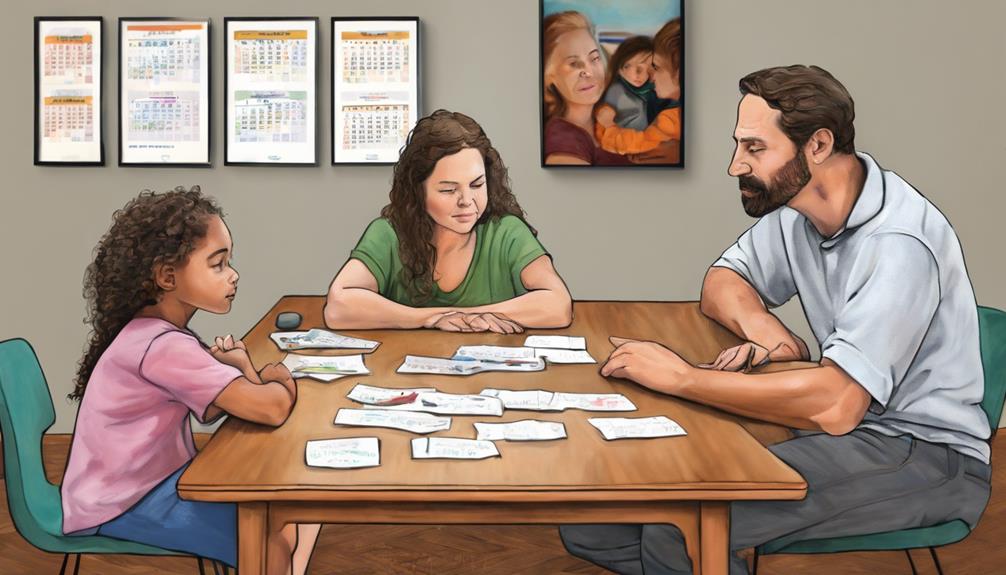When deciding to inform children about divorce, finalize the decision with your spouse first. Establish a parenting plan for stability. Wait if the decision is pending and consider older children's preferences. Early disclosure helps with adjustment. Acknowledge and validate their feelings. Encourage open communication and seek professional help if needed. Tailor explanations based on their age. Create a safe space for emotions. Strengthen the parent-child relationship for stability. Emphasize honesty and transparency. Provide support during the change. The timing greatly impacts their well-being. Understand more about addressing children's emotional needs amidst divorce for a smoother shift.
Key Takeaways
- Inform children after finalizing divorce decision with spouse.
- Establish a parenting plan for stability post-disclosure.
- Consider older children's preferences in arrangements.
- Disclosure is vital for children's better adaptation.
- Delay telling children if divorce decision is pending.
Importance of Timing in Divorce Communication
Timing plays an essential role in effectively communicating about divorce with children. Research indicates that early disclosure of divorce can aid children in adapting better to the situation.
It's vital to inform children after the divorce decision is finalized with the spouse to guarantee a united front. Establishing a parenting plan before breaking the news can provide children with a sense of stability during the turbulent times ahead.
If the decision regarding divorce is still pending or uncertain, it's advisable to delay telling the children until there's more clarity. Additionally, when making arrangements related to the divorce, it's crucial to take into account the preferences and feelings of older children.
Addressing Childrens Emotional Well-being

Addressing children's emotional well-being after a divorce is essential for their adjustment and mental health. Providing emotional support, explaining things in an age-appropriate manner, and encouraging open communication are key strategies to help children express their feelings.
Emotional Support Strategies
Acknowledging and validating children's emotions is essential in providing effective emotional support during a divorce. Encourage open communication to create a safe space for children to express their feelings of fear, sadness, and confusion.
Reassure them that experiencing a range of emotions is normal during this challenging time. Offer comfort and understanding to help them process and cope with the changes they're facing.
If children exhibit signs of prolonged distress or have difficulty coping emotionally, seek professional help to provide them with additional support. By acknowledging their emotions, creating a safe environment for communication, and offering reassurance and comfort, parents can help their children navigate the emotional challenges that come with divorce.
Age-Appropriate Explanations
To effectively support children's emotional well-being during a divorce, tailoring explanations based on their age and emotional maturity is essential. For children aged 0 to 5, provide simple explanations about who is moving out and where they will live to address their limited understanding. Children aged 6 to 11 may assign blame for the split, so acknowledge their feelings of fear, anxiety, and sadness to help them process their emotions. Kids aged 12 to 14 have a greater capacity to understand divorce-related issues, so encourage discussions and offer professional help if needed to support their emotional well-being. Utilize age-appropriate books about divorce to help children of different age groups process their emotions and understand the changes ahead.
| Age Group | Explanation Approach | Emotional Support |
|---|---|---|
| 0-5 | Simple explanations on who is moving out | Address limited understanding |
| 6-11 | Acknowledge feelings of fear, anxiety, and sadness | Help process blame and emotions |
| 12-14 | Encourage discussions and offer professional help | Support understanding of divorce-related issues |
Encouraging Open Communication
Encouraging children to openly communicate their feelings and concerns about the divorce process is essential for their emotional well-being. Creating a safe space for children to share their emotions allows them to ask questions and seek clarification about the divorce.
Providing a supportive environment for communication can help children cope better with the changes that come with divorce. Acknowledging children's emotions and validating their feelings promotes healthy emotional development during this challenging time.
Emphasizing Family Bond Amidst Divorce

During a divorce, emphasizing family unity can provide children with a sense of security and support. Strengthening parent-child relationships is vital in maintaining family bonds despite the changes.
Nurturing emotional well-being by fostering positive interactions and open communication can help children navigate the challenges with stability and continuity.
Family Unity Post-Divorce
Maintaining family unity post-divorce is essential for safeguarding children's emotional well-being. It is vital to prioritize the family bond even after separation. By offering mediation services, parents can navigate divorce while preserving a sense of unity for the children. Support systems are in place to help parents protect their children and cultivate a cooperative co-parenting relationship. Encouraging open communication and mutual respect is key to keeping the family connected despite the divorce. Providing resources such as document preparation, legal consultations, and financial advice can aid families in transitioning smoothly. By focusing on maintaining unity and prioritizing the well-being of the children, families can navigate post-divorce life more effectively.
| Family Unity Post-Divorce | |
|---|---|
| Importance | Safeguarding children's emotional well-being |
| Support | Mediation services for parents navigating divorce |
| Communication | Encouraging open dialogue and mutual respect |
Strengthening Parent-Child Relationships
To strengthen parent-child relationships amidst divorce, emphasizing the enduring family bond is paramount for providing stability and support to children. Reassuring kids that the love and care from both parents remain constant can help alleviate their anxieties.
Open communication and emotional sharing between parents and children create a secure environment where understanding can flourish. By prioritizing positive interactions, consistency, and a united front, parents can foster a sense of security and belonging for their children.
Creating a safe space where children feel valued and heard amidst the changes can strengthen the parent-child relationship during and after divorce. Emphasizing the enduring ties that bind the family together can help children navigate the challenges of divorce with resilience and stability.
Nurturing Emotional Well-Being
Highlighting the vital power of the family connection in the face of divorce is essential for fostering children's emotional well-being. Emphasize to children that the family bond remains strong despite the divorce, reassuring them that both parents will continue to love and care for them. Encourage open communication to maintain emotional well-being during the divorce process, and highlight the importance of creating a safe space for children to express their feelings and concerns.
Providing consistent support to help children navigate their emotions and maintain a sense of family unity is pivotal. By reinforcing the idea that love and care persist within the family unit, children can feel secure and nurtured amidst the changes brought about by divorce.
Honesty and Transparency in Conversations

During discussions about divorce, fostering honesty and transparency is crucial for building trust and understanding with children. Providing clear and age-appropriate explanations about the divorce process can benefit children greatly. Avoiding vague or misleading information can help reduce confusion and anxiety in children, ensuring they feel supported emotionally.
When children ask questions, responding with honesty can encourage open communication and provide the necessary emotional support during this challenging time. Transparency in discussing divorce with kids can help them feel more secure and better prepared for the changes that lie ahead.
Supporting Children Through Transition

How can parents create a supportive environment for children going through a divorce? During this challenging transition, it is crucial for parents to prioritize their children's emotional well-being. Creating a safe space for kids to express their feelings and ask questions about the divorce is essential. Encouraging open dialogue and age-appropriate communication can help children understand the changes happening in their family dynamic. It is important to reassure children that they can love both parents without feeling guilty or having to choose sides. Providing information about the logistics and future changes can help children feel more prepared for what's to come. Additionally, offering constant reassurance that both parents will continue to love and care for the children throughout the divorce process is vital.
| Supporting Children Through Transition |
|---|
| Create a safe space for children to express their feelings and ask questions about the divorce. |
| Encourage open dialogue and age-appropriate communication during the transition. |
| Reassure children they can love both parents without having to choose sides. |
| Provide information about future changes to help children understand the transition. |
Age-Appropriate Communication Strategies

To effectively communicate with children about divorce, parents should tailor their messages according to the child's age and developmental stage. For children aged 0 to 5 years, provide simple explanations about who's moving out and where the child will live.
Children between 6 to 11 years may assign blame for the split, acknowledge their feelings of fear, anxiety, and anger. Encourage discussions and questions for 12 to 14-year-olds to enhance understanding and respect their desire for independence.
Using age-appropriate books about divorce can help children process emotions and understand the situation. It's essential to adapt communication strategies to the child's developmental stage to make sure they comprehend the news of the divorce effectively.
Frequently Asked Questions
At What Age Is a Child Most Affected by Divorce?
Children around the age of 10 are most affected by divorce. Emotional issues tend to be more pronounced in this age group. Younger children may show less immediate impact, while adolescents may struggle more with the concept of divorce.
How Do You Explain Divorce to a 4 Year Old?
Explaining divorce to a 4-year-old involves using simple terms. Parents loving the child but living in different homes can be compared to friends playing in separate sandboxes yet still caring deeply.
How Do You Tell Your Child You Are Separating?
In telling a child about a separation, a parent should choose a calm setting, use simple language, reassure the child of continued love, and be prepared to answer questions honestly. Encouraging open communication is vital.
What Not to Tell Your Kids About Divorce?
Parents should avoid sharing intimate details, blaming their partner, involving children in conflicts, using them as messengers, or making negative comments about the ex-partner. These actions can harm kids' emotional well-being during a divorce.
Conclusion
To summarize, research indicates that children who are informed about their parents' divorce early on have better emotional outcomes. Studies suggest that children who are told about the divorce promptly are more likely to adapt to the changes and cope effectively.
It's essential for parents to communicate openly and honestly with their children, providing them with support and reassurance throughout the process. This approach can help children navigate the challenges of divorce with resilience and understanding.











